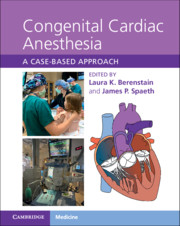Book contents
- Congenital Cardiac Anesthesia
- Congenital Cardiac Anesthesia
- Copyright page
- Dedication
- Contents
- Contributors
- Introduction
- Chapter 1 A Congenital Heart Disease Primer
- Section 1 Left-to-Right Shunts
- Section 2 Right-Sided Obstructive Lesions
- Section 3 Left-Sided Obstructive Lesions
- Chapter 14 Critical Aortic Stenosis
- Chapter 15 Aortic Stenosis
- Chapter 16 Subvalvular Aortic Stenosis
- Chapter 17 Supravalvular Aortic Stenosis
- Chapter 18 Hypertrophic Cardiomyopathy
- Chapter 19 Coarctation of the Aorta
- Chapter 20 Shone Complex
- Section 4 Complex Mixing Lesions
- Section 5 Single-Ventricle Physiology
- Section 6 Heart Failure, Mechanical Circulatory Support, and Transplantation
- Section 7 Miscellaneous Lesions and Syndromes
- Index
- References
Chapter 18 - Hypertrophic Cardiomyopathy
from Section 3 - Left-Sided Obstructive Lesions
Published online by Cambridge University Press: 09 September 2021
- Congenital Cardiac Anesthesia
- Congenital Cardiac Anesthesia
- Copyright page
- Dedication
- Contents
- Contributors
- Introduction
- Chapter 1 A Congenital Heart Disease Primer
- Section 1 Left-to-Right Shunts
- Section 2 Right-Sided Obstructive Lesions
- Section 3 Left-Sided Obstructive Lesions
- Chapter 14 Critical Aortic Stenosis
- Chapter 15 Aortic Stenosis
- Chapter 16 Subvalvular Aortic Stenosis
- Chapter 17 Supravalvular Aortic Stenosis
- Chapter 18 Hypertrophic Cardiomyopathy
- Chapter 19 Coarctation of the Aorta
- Chapter 20 Shone Complex
- Section 4 Complex Mixing Lesions
- Section 5 Single-Ventricle Physiology
- Section 6 Heart Failure, Mechanical Circulatory Support, and Transplantation
- Section 7 Miscellaneous Lesions and Syndromes
- Index
- References
Summary
Hypertrophic cardiomyopathy is a common, autosomal dominant cardiac disease with heterogeneity of expression. Although predominantly an obstructive lesion, it is also characterized by dysrhythmias, diastolic dysfunction, and subendocardial ischemia. Knowledge of the pathophysiology of the disease is imperative in order to provide safe anesthetic care. A comprehensive preoperative evaluation is important in identifying high-risk patients with more malignant forms of the disease. This chapter reviews the abnormalities associated with hypertrophic cardiomyopathy. In addition, strategies to maintain normal sinus rhythm and blood pressure and to prevent catecholamine surges are discussed with specific reference to anesthetic agents and their effects in patients with hypertrophic cardiomyopathy.
Keywords
- Type
- Chapter
- Information
- Congenital Cardiac AnesthesiaA Case-based Approach, pp. 113 - 120Publisher: Cambridge University PressPrint publication year: 2021



